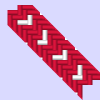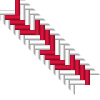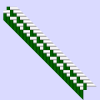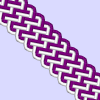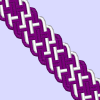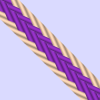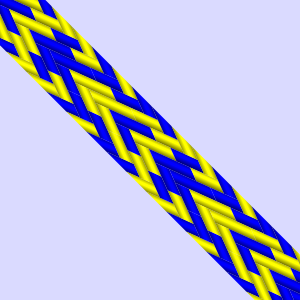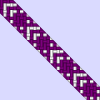Welcome to FingerTips - a site for tools to assist in
designing patterns for finger held loop braiding and also
hand-held loop braiding (Kute-uchi).
These web tools were composed by Gary Mitchell
Welcome! In 2018 the site has some new planners for pick-up braids (non-automatic patterns)
Index
The very first tool I put online:
-
7-loop Spanish Braid (double layered flat)
|
For this braid there are 596 2-colour designs. There
are subtly different versions of the pattern planner.
One for each of the ways in which the braid can be made.
The versions differ only in how the loops are turned
when taken. Of all the planners I have done so far
it is this one - the 7-loop spanish braid - which has
the most interesting pattern possibilities.
|
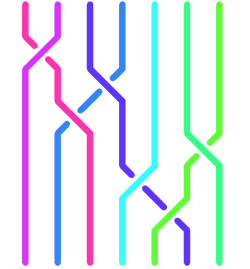
Ignoring turns the mathematical description (the braid word) of the moves used in the planner to create this braid is aCBFde
|
-
-
Planner: 7-loop Spanish Braid : all four
reversed turns alike. D-shaped
cross-section
-
This braid has one narrower flat surface and one
wider convex surface giving a bevelled
appearance.
Method:
Either all four turns are done take from below
bottom shank OR all four turns are done take
from above top shank - but no mixture!
Hint: try IDs
. 28
. 43
. 109
. 145
. 157
.
327
.
338
.
413
.
444
.
585
.
596
. - then apply RV or SX or modify!
-
-
Planner: 7-loop Spanish Braid : balanced
reversed turns. Rectangular cross-section.
-
This braid has two flat surfaces of equal width.
Method:
Four reversed turns: #1 and #3 one way (e.g.
take from above top shank) and #2 and #4 done
the other way (e.g. take from below bottom
shank)
Hint: try IDs
- then apply changes with RV or SX or modify each shank!
-
-
Planner: Derivative of Hollow 7-loop Spanish Braid
: using alternating turn directions.
-
This braid has symmetric edges and can show mirror symmetry patterns.
Hint: try IDs
-
-
Planner: Derivative of 7-loop Spanish Braid
: using alternating cycles.
-
This braid has asymmetric edges.
Hint: try IDs
596
- Pick Up Planner for 7-loop Spanish Braid
Pick Up Planner for 7-loop Spanish Braid
Use 7 bi-colour loops. Use this planner to know when to turn or not turn when taking loops.
Please note that this planner is still being developed and is online for error checking purposes
so far (January 2018). It will be formally released when this paragraph is removed (expected February 2018)
-
-
Planner: Doug's variation of 7-loop Spanish Braid :
4 loop transfers per cycle with 2 reversed turns (URUR).
|
This braid is ROUND. The planner shows a projection of the braid onto a flat surface. That is to say like a snakeskin.
For a preview of the finished braid you could cut around the design and roll it into tube with the matching edges overlapping.
|
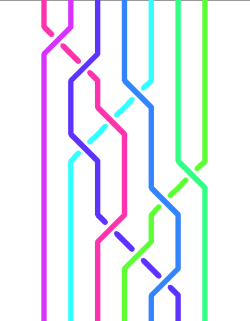
Ignoring turns the mathematical description (the braid word) of the moves used in the planner to create this braid is abDCBFEcde
|
Using all plain loops there are only 10 different designs:
1
6
74
96
103
362
422
444
459
465
Using all bi-coloured loops there are only 10 different designs. However most are (to my eye) just random.
These 2 are interesting:
469
596
Note:
There is a subtle difference between 469 you
of this braid and
364
of the next. Can you see it?
-
Hint: try these IDs
- 7 plain loops
-
103
362
422
444
459
465
- 5 plain loops , 2 bi-colour loops
-
9
- 4 plain loops , 3 bi-colour loops
-
14
18
35
- 3 plain loops , 4 bi-colour loops
-
70
82
83
- 2 plain loops , 5 bi-colour loops
-
227
228
229
- 1 plain loop , 6 bi-colour loops
-
463
- 7 bi-colour loops
-
469
596
-
-
Planner: Doug's variation of 7-loop Spanish Braid :
4 loop transfers per cycle but now all 4 turns are reversed (RRRR).
This braid is ROUND. The planner shows a projection of the braid onto a flat surface. That is to say like a snakeskin.
For a preview of the finished braid you could cut around the design and roll it into tube with the matching edges overlapping.
-
Hint: try IDs
- plain loops : 5 one colour and 2 of another
-
Most of these example designs for this braid exhibit an element of symmetry known as a 21 screw axis.
You can read more about such symmetry for
a 3D object which has regular repeats at
Rotation and Screw Axes
76
99
107
- plain loops : 4 one colour and 3 of another
-
Most of these example designs for this braid exhibit an element of symmetry known as a 21 screw axis.
You can read more about such symmetry for
a 3D object which has regular repeats at
Rotation and Screw Axes
364
425
459
466
- plain loops and bi-colour loops
-
67
193
- bi-colour loops only
-
596
- Pick Up Planners for Doug's variation of 7-loop Spanish Braid
For these braids 7 bi-colour loops are always used. There are
4 loop transfers per cycle with varying (i.e 0 to 4) turns when taking loops to produce a pattern.
Dietlind Wagners website
has
a section on fingerloop braids .
She also sells at a modest price a
small booklet on fingerloop braids.
All in German but after experience from other instruction sites even those with no knowledge of German
will recognise the illustrated instructions.
I will be adding more but to begin with we have
-
Planner: 6-loop Diagonal
-
A 6-loop flat weave.
The pattern for the 6-loop braid "diagonal stripes
" which is described and illustrated on page 16 in
Dietlind Wagner´s booklet (in German) corresponds to
the ID 190.
On the
LMBRIC web site
of Masako Kinoshita there are
detailed instructions for making traditional Guajiro Indian
Braids from Colombia .
These are finger-held loop manipulation.
Several braids are described in
the original notes (in Spanish)
I will be adding more but to begin with we have
-
Planner: Yaliwansu Braid (2nd variation)
-
A 7-loop thick braid.
The two patterns for the Yaliwanasu braid (second
variation) are described and illustrated on
pages 77-81 of the original notes (in Spanish)
correspond to the IDs
295
and
27
in this planner.
Another design using plain loops which is attractive is
291
. There are only 10 patterns using plain loops: 1 3 8 25
27 80 82 98 291 295. Other symmetric designs using
bi-coloured loops include
595
. The patterns
11
. and
42
. also use bi-coloured loops but are simpler.
On the
LMBRIC web site
of Masako Kinoshita there are
detailed instructions for making Kute-Uchi traditional
Japanese braids.
These are hand-held loop manipulation.
- A outside around open
- B outside around crossed
- C inside through open
- D inside through crossed
- twist 180 then outside around open
I will be adding more but to begin with we have small
numbers of loops
Braid AADC.4-3
A 7-loop flat wide braid.
Some of the more symmetrical patterns are IDs
8
25
30
85
96
278
534
596
|

| Ignoring turns the mathematical description (the braid word) of the moves used in the planner to create this braid is ABCfedabcFED
|
Braid DD.3-3 x 2
- A 12-loop thick braid.
This mimics two workers each using 6 loops and working
in parallel and exchanging near-side loops.
In fact one person can handle these loops alone.
Some of the more symmetrical patterns are IDs
Sorry - this 12-loop braid has so many permutations that the designer does not work due to
limitations of maxmimum file size on the current account on this web service. If there is sufficient interest
I can make an effort to work around this limitation.
In the meantime here are some static non-interactive pages.
SX6578
,
7954
,
7830
,
293401
,
349180
,
349326
,
349844
,
350021
,
350060
,
350061
,
350062
,
350063
,
350064
Traditional 6-loop braid described in LMBRIC Newsletter #8
A 6-loop flat braid adapted from "6-loop 3-ridge twin flat braids with a 2/1/2 pattern"
in LMBRIC #8.
Adapted as a flat braid for one worker.
|

| Ignoring turns the mathematical description (the braid word) of the moves used in the planner to create this braid is Cdeba
|
Some of the more symmetrical patterns are IDs
6 ,
49 ,
68 ,
70 ,
170 ,
180
Braids from Ingrid Crickmore's
contribution to "Threads That Move - Proceedings of the
Second International Conference on Braiding.
The 4 Transfers and subsequent exchange are as described as in
the
"Threads that Move" book
page 65.To understand the many options for making double braids
I would recommend
buying the book from shop.braidershand.com
from the
Braid Society
.
-
6-loop double braid - Structure #3 "Solid
Rectangle"
-
Planner: 6-loop Double Braid 4 reversed
turns and C-C exchange
-
The sequence of loop transfers is as described
on page 65 of the book "Threads that Move
". The detail for the turns is:
-
clockwise
-
anticlockwise
-
anticlockwise
-
clockwise
- repeat above 4 steps in mirror image on the other hand
-
C-C exchange (C right goes through C
left)
An equivalent description is
-
take top shank from above
-
take from within and apply anticlockwise
-
take top shank from above
-
take from within and apply clockwise
- repeat above 4 steps in mirror image on the other hand
-
C-C exchange (C right goes through C
left)
|

Ignoring turns the mathematical description (the braid word) of the moves used in the planner to create this braid is bADeC
|
Using only plain coloured loops there are only 8 possible designs:
1
3
8
22
27
75
80
182
Using all combinations of plain and bi-colour loops there are 190 2-colour IDs.
However remember that applying the surface exchange operator (SX = flipping the starting orientation of all the bi-coloured loops present)
the result is something which looks very different.
Excluding simple colour reversals (RV) this braid has 356 possible designs.
The two sides of the braid are unequal. One is convex the other flat.
The appearance of the convex side can be changed slightly by pressing/stretching or constricting the braid.
The appearance of the flat side barely changes.
Hint: start with any of the these IDs and apply RV or SX or modify!
| Convex Side: stretched
|

|
| 74 |
-
6-loop double braid - Structure #6 "
Semi-flat,humped"
-
Planner: 6-loop Double Braid 2 reversed
turns and C-C exchange
-
The sequence of loop transfers is as described
on page 65 of the book "Threads that Move
". The detail for the turns is:
-
anticlockwise
-
clockwise
-
unreversed
-
unreversed
- repeat above 4 steps in mirror image on the other hand
-
C-C exchange (C right goes through C
left) == (C left around C right)
An equivalent description is
-
take bottom shank from below
-
take from within and apply clockwise
-
take from within (unreversed)
-
take from within (unreversed)
- repeat above 4 steps in mirror image on the other hand
-
C-C exchange (C left goes through C
right) == (C right around C left)
|

Ignoring turns the mathematical description (the braid word) of the moves used in the planner to create this braid is is bADeC
|
Using only plain coloured loops there are only 8 possible designs:
1
3
8
22
27
75
80
182
Hint: try IDs
- apply RV or SX or modify!
Example start with
75
.. and get the "trellis" pattern
:-)
Example start with
80
.. and get the "Angry Bird" pattern
:-)
Notes
-
7-loop double braid - Structure: Hollow
A sequence of turns and transfers not presented in
the book - but a simple variation on what is
there.
braid.
-
Planner: 7-loop Plain Weave Thick Braid 2 reversed
turns and D passes from hand to hand (psuedo exchange)
-
The sequence of loop transfers is similar to that as described
on page 65 of the book "Threads that Move
":

The book (ISBN: 978-0-9573127-0-8) can be bought from
shop.braidershand.com
or from the
Braid Society
There you will also see a detailed explanation of how to lift a loop up through another one.
Simplified instructions for this braid appear at foot of each design.
|
|

Ignoring turns the mathematical description (the braid word) of the moves used in the planner to create this braid is aBcFeD
|
Hint: The symmetric designs are: IDs
- apply RV or SX or modify!
Compare
this braid ID 466
with a very similar pattern on the Tollemache #18 5-loop braid
ID 41.
They are indeed subtly different. Can you see the difference?
- Pick Up Planner for 7-loop Plain Weave Thick Braid
Pick Up Planner for 7-loop Plain Weave Thick Braid
A planner for non-automatic patterns. You always start with 7 bi-colour loops.
In each braiding cycle there are 6 operations and sometimes you turn the taken loop and sometimes not. For the
design you compose then for each of the 6 operations the
planner assists you by showing the colour of shank which must be up on the transferred loop when it arrives at its destination.
The sequence of loop transfers is similar to that as described
on page 65 of the book "Threads that Move
".
There you will also see a detailed explanation of how to distend a loop and raise another one through it.
Simplified instructions for this braid appear at foot of each design.
-
8-loop double braid V-fell (D-D exchange) - Structure 5 = Grooved Rectangle
|
The sequence of turns and transfers presented in
the book - but no planner yet.
|

Ignoring turns the mathematical description (the braid word) of the moves used to create this braid is bcAFEgD
|

Note: This braid is V-fell
|
-
8-loop double braid A-fell (A-A exchange) - Structure 4 = Hollow Rectangle?
|
A sequence of turns and transfers not presented in
the book - but a simple variation on what is
there. This braid has a D-shaped profile.
|

Ignoring turns the mathematical description (the braid word) of the moves used in the planner to create this braid is BAcfgEd
|

Note: This braid is A-fell
|
-
Planner: 8-loop Double Braid 2 reversed
turns and A-A exchange
-
The sequence of loop transfers is as described
on page 65 of the book "Threads that Move
". The detail for the turns is:
-
clockwise
-
unreversed
-
anticlockwise
-
unreversed
-
A-A exchange (A left through A right) ==
(A right around A left)
An equivalent description is
-
take top shank from above
-
take from within
-
take top shank from above
-
take from within
-
A-A exchange (A left goes through A
right) == (A right around A left)
Hint: try IDs
21
,
540
,
1231
,
1133
,
1628
,
1778
,
1973
,
1988
,
2100
,
2101
,
2102
.- apply RV or SX or modify!
Or start with
2101
.the "reversed edge" pattern :-)
- Pick Up Planner for Ingrid' 10-loop Double Braid
Pick Up Planner for Ingrid' 10-loop Double Braid
Please note that this planner is still being developed and is online for error checking purposes
so far (December 2017). It will be formally released when this paragraph is removed (expected January 2018)
This requires 5-loops on each hand i.e using the thumbs too.
Ingrid Crickmore's videos on YouTube show how to do this.
You will need 10 bi-colour loops with contrasting colours. Start with all loops
having the same colour on the upper shank.
-
12-loop double braid - Solid Structure
A sequence of turns and transfers not presented in
the book - but described on Ingrid's website.
This braid is solid.
-
Planner: 12-loop Double Braid 4 reversed
turns and D -D exchange
-
The sequence of loop transfers is as described
in Ingrid's videos.
Hint: try these IDs which are presented in increasing symmetry within each group
- Using only plain loops - both sides of braid have similar patterns.
-
545
50586
53088
349176
350021
7956
350046
53091
350064
53092
350026
7691
350063
350064
349180
- Using only bi-colour loops - the other side of the braid has the colour inverse of the first side.
-
293401
306946
323647
335269
349590
338724
350041
350062
350063
349180
- Using a mixture of plain and bi-colour loops - the two sides of the braid have different designs.
There are many possibilities.
-
161658
161668
161673
170036
170040
174739
174746
174752
174756
174758
180006
180025
180037
180044
180056
180061
180069
180072
180074
185763
185783
185795
185802
185813
185822
185827
185835
185838
185840
188434
188441
188459
188463
188469
188472
188474
189179
189181
189320
189370
189387
306935
306938
306940
306941
306944
323642
323644
323645
335163
335180
335191
335206
335218
335232
335235
335244
335251
335256
335260
335264
335267
346054
346058
346059
346063
346066
348459
348460
349177
349178
349179
349181
349184
349578
349581
349585
349588
350025
350061
97
6462
7923
7962
81274
98332
104172
106191
107173
107451
107545
346874
348604
349574
349993
546
50639
53092
350026
7691
-
12-loop double braid - Structure: Hollow
A sequence of turns and transfers not presented in
the book - but described on Ingrid's website.
This braid is hollow - this is just one of the ways it can be squashed flat.
-
Planner: 12-loop Double Braid 2 reversed
turns and D-D exchange
-
The sequence of loop transfers is as described
in Ingrid's videos.
Hint: try these IDs which are presented in increasing symmetry
- Using only plain loops
-
545
50586
53088
349176
350021
7960
350047
53091
350064
- Using only bicolour loops
-
306934
323641
335150
344307
350020
342916
350031
350062
350063
349180
- Using a mixture of plain and bicolour loops
-
183665
183858
185921
186570
186798
187011
187448
187663
187864
188102
188213
188272
188521
188576
188734
188875
189018
189084
189093
189199
189224
189359
189381
189391
314450
319648
321725
323095
323532
328139
331587
334697
337819
339841
340837
341342
341719
342654
343185
343516
343695
343943
344065
344239
344256
346570
347116
347422
348228
348295
349001
349149
349177
349178
349179
349427
349472
349699
349812
349885
349971
350033
350061
100
6605
7931
7962
86019
97162
103763
106209
106870
107511
107576
348315
349174
349504
349817
552
52132
53092
350039
7872
.- apply RV or SX or modify!
A proper list of symmetric patterns for this braid will be added soon!
-
12-loop double braid - Structure: Both edges have grooves.
A sequence of turns and transfers not presented in
the book - but described on Ingrid's website.
This braid has grooves on each edge.
-
Planner: 12-loop Double Braid 2 reversed
turns and D-D exchange: sides have grooves
-
The sequence of loop transfers is as described
in Ingrid's videos.
Hint: try these IDs which are presented in increasing symmetry
- Using only plain loops
-
549
50971
53068
349129
350015
7962
350062
53091
350063
- Using only bicolour loops
-
317580
337167
346272
349180
350058
340367
350059
349701
350064
303867
- Using a mixture of plain and bicolour loops
-
82
4473
7960
7961
66865
101392
101820
102100
102264
107428
107550
339180
341228
350060
350061
506
38968
53092
349530
7274
.- apply RV or SX or modify!
A proper list of symmetric patterns for this braid will be added soon!
For further information see the
book of the Braid Society 2012 Conference Proceedings -
"Threads that Move"
available from the
Braid Society
.
-
Tollemache #5 - a 5-loop flat braid
-
Tollemache #18 - Only half of the braid i.e. adapted as a single worker
reduction: a 5-loop flat braid
-
Tollemache #19: a 7-loop hollow braid - with 2 reversed
turns
-
There are
Instructions for Tollemache 19 on www.silkewerk.com web site (external link).
Planner: 7-loop Tollemache #19 Braid
-
Hint: try IDs
5
,
9
,
16
,
42
,
49
- apply RV or SX or modify!
-
Tollemache #20: a 7-loop flat braid - with one reversed
turn
-
There are
Instructions for Tollemache 20 on www.silkewerk.com web site (external link).
Planner: 7-loop Tollemache #20 Braid
-
Hint: try IDs
3
,
8
,
25
,
32
,
85
,
96
,
278
,
327
- apply RV or SX or modify!
-
Tollemache #23: a 7-loop flat braid - with one 360
degree turn.
-
Planner: 7-loop Tollemache #23 Braid
-
Hint: try IDs
8
,
32
,
85
,
278
,
327
- apply RV or SX or modify!
-
Braid 23.1
-
Planner: 16-Strand braid from Peru #23.1
-
Some of these designs can be acheived using a simpler recipe but are included as an illustration of
possibilities.
- designs identical or similar to those illustrated in Rodrick Owens book for this or other braids.
8079,
8211,
8372,
8380
- designs which could be adapted for 3 colours
8123,
8193,
8261,
8306,
8335,
8367
- designs with wavy lines
8154,
8357
- designs with two opposite sides simple monochrome
258,
357,
539,
650,
655,
657
- simple linear templates (to modify!)
318,
6860,
8287,
8327
- streaks
414,
617,
7901,
- click on the RV button to see with colours reversed or click on SX or click on any cell to modify!
Explore and have fun! :-) Gary Mitchell










